i to the power i
Categories: complex numbers imaginary numbers

The imaginary unit i is defined to be the positive square root of -1. But what is i to the power i? Is it even possible to calculate, and what does it mean?
As we will see, it is possible to calculate i to the power i, and the result is quite surprising in a couple of different ways. But we will start with a quick recap on the real powers of complex numbers, in particular the real powers of i.
Modulus-argument form for multiplication
We will be using the modulus-argument form for complex numbers, where a complex number z is represented as a radius r (called the modulus) and an angle Θ (called the argument):
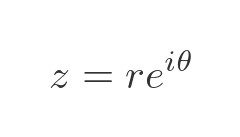
The modulus of z is the distance from the origin to the point z on an Argand diagram. The argument of z is the angle z makes with the x-axis:
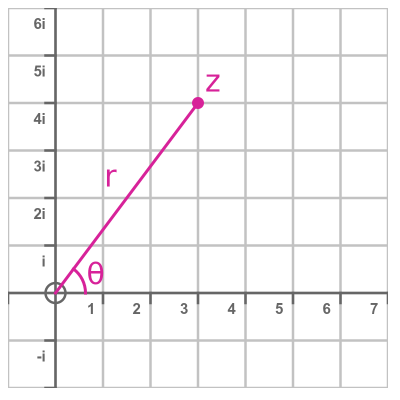
When we multiply two complex numbers z1 and z2 that are expressed in this form, the normal rules of the exponential function apply:

We multiply the moduli r1 and r2. We add the arguments Θ1 and Θ2. That is exactly the same as we would do if the exponents were real numbers.
The value i in modulus-argument form
We will be using i quite a lot, so it is useful to know its modulus-argument form. Here is i on an Argand diagram:

i is 1 unit vertically above the origin. So the length r is 1, and the angle is π/2 radians (which is 90 degrees of course). Here is the exponential form of i:
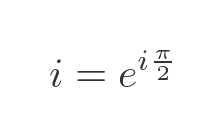
If we multiply any number z by i, then in modulus-argument form this is:

In other words, multiplying by z by i simply rotates z by π/2 radians about the origin.
Integer powers of i
Before calculating i to the power i, it is worth looking at i raised to a real power, as this will give us a couple of insights into the problem. We can calculate i squared like this:

This value has a unit length and an angle of π radians (half a full turn). This makes it equal to -1. But we already know that i squared is -1, by definition. So (as expected) the modulus-argument form of i squared gives the same result as simple complex number multiplication.
We can find i cubed in the same way. This time the angle is 3π/2 radians (three-quarters of a full turn), so the result is -i:

i to the fourth has an angle of 2π radians a full turn), so the result is 1:

Here are i and its second, third and fourth powers plotted on an Argand diagram:
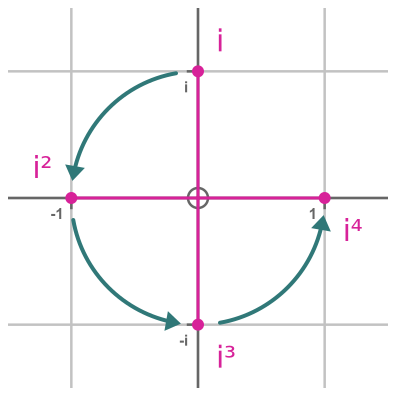
It is no great surprise that i to the fourth power is 1. i to the fourth is just i squared then squared again, and since i squared is -1 then we would expect i to the fourth to be 1.
We can generalise this and say that i to any integer power is equal to:

Using this we can find the fifth, sixth and seventh powers on the Argand diagram:
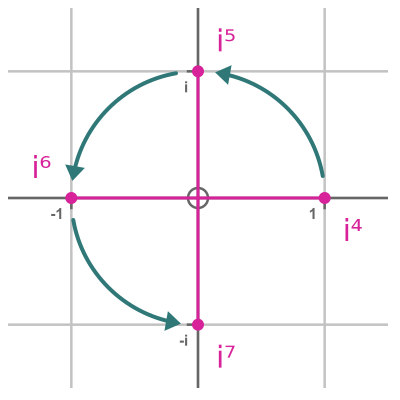
Higher integer powers of i continue rotating round and round the unit circle.
Takeaways
There are two important takeaways from this. The first is that raising i to the power n, in modulus-argument form, works in the same way as raising any other exponential to a power n. We just multiply the exponent by n:
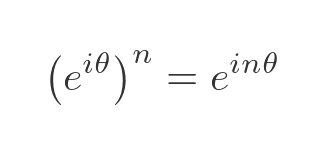
The second is that there are infinitely many ways to express i in modulus argument form. Since i to the fourth is equal to 1, it follows that:

In modulus-argument form:

In fact, for any complex number z with argument Θ, if we add an integer multiple of 2π to Θ, we will get the same number. This follows from Euler's formula:

Adding a multiple of 2π to the angle does not change the value of the sine or cosine functions, because those functions are periodic with period 2π, so:

Integer roots of i
So what is the square root of i? Well, the square root of a real number x is given by raising x to the power one-half. What happens if we try the same thing with i?
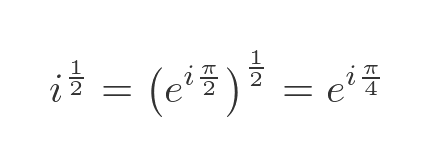
But remember that i can also be written as i to the power 5. If we take the square root of this alternate form we get a second square root:
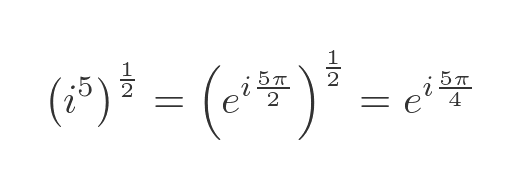
We can draw these two roots on an Argand diagram:
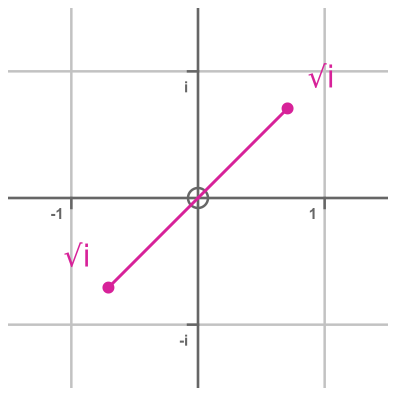
We can do this again with i to the power 9 (which is also equal to i):

This gives a result that has an argument of π/4 plus 2π. Since adding 2π has no effect on the value of a complex number, this result is identical to the original case where the argument was π/4. There are only two distinct square roots of i.
In fact, every complex number (except 0) has two distinct square roots, 3 distinct cube roots, and n distinct nth roots.
Takeaway
i raised to a power p can sometimes have multiple values. Those values can be found by calculating the powers of the following equivalent numbers:
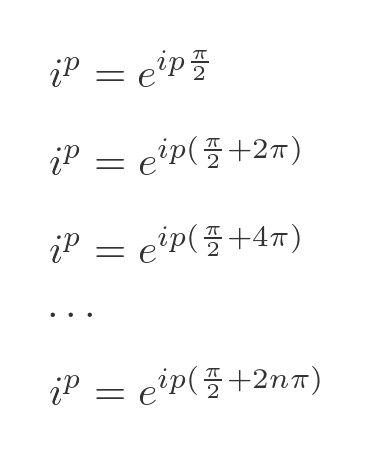
Not all of these roots are necessarily distinct.
i to the power i
So now we are in a position to calculate the value of i to the power i. We will assume that we can raise i to the power i simply by setting p to the value i in the formula above. This can be shown to be true, but we won't prove it here.
Here is the result:

This is a very interesting result. The two i terms multiply to give -1, so the exponent is now a real number. This means that the power is a real number expression!
i to the power i is simply the exponential of -π/2. Which has a real value of approximately 0.207880.
But it gets a little weirder. We also have to consider the other possible results based on the alternate modulus-argument forms of i. For example when n equals 1, we add 2π to the exponent:
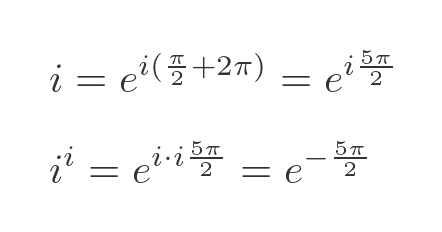
This gives a value of approximately 0.000388203.
We can use negative values of n too, of course. When n equals -1, we subtract 2π from the exponent:

This gives a value of approximately 111.318.
Since this formula is based on the exponential function of a real number, every different value of n will give a unique, real result.
So i to the power i has an infinite number of solutions, and they are all real numbers.
See also
- Imaginary and complex numbers
- Complex number arithmetic
- Argand diagrams
- Why does complex number multiplication cause rotation?
- Modulus-argument form of complex numbers
- De Moivre's theorem
- Euler's formula - proof
- Complex powers and roots of complex numbers
- Semiprocal numbers - z to the power i
- Complex polynomials
- Complex number trigonometry functions

Join the GraphicMaths Newletter
Sign up using this form to receive an email when new content is added:
Popular tags
adder adjacency matrix alu and gate angle answers area argand diagram binary maths cartesian equation chain rule chord circle cofactor combinations complex modulus complex polygon complex power complex root cosh cosine cosine rule cpu cube decagon demorgans law derivative determinant diagonal directrix dodecagon eigenvalue eigenvector ellipse equilateral triangle euler eulers formula exercises exponent exponential exterior angle first principles flip-flop focus gabriels horn gradient graph hendecagon heptagon hexagon horizontal hyperbola hyperbolic function hyperbolic functions infinity integration by parts integration by substitution interior angle inverse hyperbolic function inverse matrix irrational irregular polygon isosceles trapezium isosceles triangle kite koch curve l system line integral locus maclaurin series major axis matrix matrix algebra mean minor axis n choose r nand gate newton raphson method nonagon nor gate normal normal distribution not gate octagon or gate parabola parallelogram parametric equation pentagon perimeter permutations polar coordinates polynomial power probability probability distribution product rule proof pythagoras proof quadrilateral questions radians radius rectangle regular polygon rhombus root sech segment set set-reset flip-flop sine sine rule sinh sloping lines solving equations solving triangles square standard curves standard deviation star polygon statistics straight line graphs surface of revolution symmetry tangent tanh transformation transformations trapezium triangle turtle graphics variance vertical volume volume of revolution xnor gate xor gate